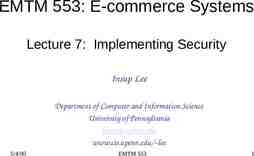Organelle Case Study Diseases that affect specific organelles
10 Slides678.96 KB
Organelle Case Study Diseases that affect specific organelles
Task 1: Prior Knowledge and Research Read about each of the following diseases that affect the organelles Take notes! Put on your doctor hat, delve into your investigative skills, and diagnose the patients. Dr. Ben Carson, MD. Author of “Gifted Hands” and “Think Big”. Look him up! Truly an inspiration!
Diseases that affect the organelles 1. Tay-Sachs Disease: http://www.mhhe.com/biosci/ap/foxhumphys/student/olc/h-re ading10.html 2. Cystic Fibrosis Investigation (Learn.Genetics.Utah.edu) http://learn.genetics.utah.edu/content/genetherapy/gtintro/ 3. Mitochondrial Disease: http://www.umdf.org/site/pp.aspx?c 8qKOJ0MvF7LUG&b 79 34633 4. Friedrich’s Ataxia: https://docs.google.com/a/aggies.ncat.edu/viewer?a v&q c ache:bt9Ee3cjsRcJ:www.muscle.ca/fileadmin/National/Muscul ar Dystrophy/Disorders/427E Friedreichs Ataxia 2007.pdf & hl en&gl us&pid bl&srcid ADGEEShjcRvZfxI5sZvKIG9qoPj 7t197KVbSu87chCZmb32jdg8j8VLzgdLtrEnP2QUK8k3bKXQn 4NyY8VM1Kfif-D2WzpQ5j8qVFLnMxrap8MqEYSX7YnTsjryFjQKI G9OEg63lqHLw&sig AHIEtbQW4QJUSE1WwnRPJ88gnvfokd6
Task 2: Patient Case Studies Using your knowledge about the cell, organelle, and organelle diseases, do the following: 1. Tell which disease/disorder afflicts EACH patient and. 2. Tell which organelles are affected by the disease 3. Write the answers in your notebook. 4. You may ask peer for help, but be leery of getting advice from other doctors (trust your own instincts and diagnosis).
Patient #1: Mary Mary is a fifty-five year old female, who arrived in the ER at 4:35 p.m. with complaints of severe fever and pain. The attending physician took blood work and revealed that there was a high concentration of oxidative enzymes in the blood such as catalase, D-amino acid oxidase, and uric acid oxidase. In addition, there were relatively high levels of fatty acids in the blood, which the physician suggested they were not being properly metabolized. A density gradient procedure found that an organelle approximately 0.5 microns in diameter was missing. The physician also diagnosed Mary with having gout in the joints in her hands and feet, a condition which is caused by the accumulation of uric acid. That same night around 11:00 p.m., Mary began to lose feeling in her lower back. The doctors performed a routine spinal tap (ST) to see if there was an infection in her cerebral spinal fluid. This test turned out to be negative; however, the attending physician did take a
Patient #2: Lauren Lauren is a senior at a nearby high school. She is a good student who does her work on weekdays and likes to party on the weekends with her friends. A few months ago, Lauren developed a persistent cough that has worsened over time. She has also had trouble breathing over the past week or so. Her parents decided it was time she see a doctor and made an appointment with the family physician. Lauren arrived at the doctor's office the following day. The doctor asked her a number of questions about her health history and daily habits, including, whether or not she smoked cigarettes. Lauren responded that she started smoking cigarettes (about 2 per day) her freshman year of high school and does not intend to quit anytime soon. The doctor decided it was necessary to take a biopsy of the cells that line the bronchus (passageway to the lungs). After several days, the biopsy report has come back along with a micrograph of the bronchial cells. Lauren's cigarette smoking has badly damaged these organelles which are responsible for moving
Patient #3: Valerie Valerie is a studious 15 year old who is also a valuable member of her school's field hockey team. They are 15-1 this year and have a chance at winning the state championship. However, Valerie recently began feeling ill with noticeable signs of a high fever. After several days, her parents decided to take her to the ER and the attending physician admitted her to the hospital with an ongoing bacterial infection. After several more days, doctors are perplexed that her body is unable to fight off the infection. They decide to take a blood sample and have it sent to the lab for analysis. Lab results indicate that the vacuoles in her white blood cells are successfully trapping the bacteria. However, this organelle is not binding to the vacuoles and releasing the enzymes necessary to break down the bacterial cell walls. Identify the organelle so doctors can begin providing the proper treatment to Valerie.
Patients #4: Jim and Lisa (fertility issues) Jim and Lisa have lived in the state of New Jersey most of their lives. They are both in their early 30's and recently married. They have been trying to have their first child for a number of months but Lisa has been unable to get pregnant. Recently, Jim and Lisa decided to go to their family physician to see if there may be something wrong. The physician obtained a sample of Jim's sperm cells and had it sent to a lab for microscopic analysis. After several days, the physician received a micrograph of the sperm cells and noted a structural defect in the organelle responsible for cell movement. Analyze the micrograph (see "Case Study #4" image below) and determine the organelle responsible for Jim and Lisa's inability to have a baby.
Patient #5: Olivia Olivia is a sixteen year old track star at a local school nearby. She arrived in the ER at 5:03 p.m. with complaints of extreme muscle weakness and loss of muscle coordination, particularly in her arms and legs! She told the attending physician that for the past few days, she had been pretty exhausted with little energy to do anything. Blood taken did show one particular abnormality. Her glucose levels were rather high although she was an athlete and did mention she ate carbohydrates the night before a race. However, this notion could be dismissed since she did not have a race in the past week. The doctors concurred that something else must be going on to render such high glucose levels (i.e. something was not breaking down these sugar molecules). In addition, the doctors ordered for a muscle biopsy to be performed. After viewing the tissue sample under the microscope, the doctors saw that the muscle fibers were ragged red which contained mild accumulations of glycogen and decreased activity for the enzyme cytochrome c oxidase
On your paper Patient #1: Mary has and this affects the Patient #2: Lauren has and this affects the . Patient #3: Valerie has and this affects the . Patient #4 (Jim and Lisa): has and this affects the . Patient #5: Olivia has and this affects the . Be prepared to discuss your answers on 2.25.14















